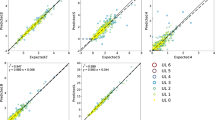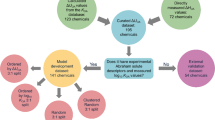Abstract
Purpose. The passage of molecules across cell membranes is acrucial step in many physiological processes. We therefore seek physicalmodels of this process, in order to predict permeation for new molecules,and to better understand the important interactions which determinethe rate of permeation.
Methods. Several sets of cell permeation data reported byCollander have been correlated against calculated Linear Free Energy Relation(LFER) descriptors. These descriptors, taken as the sum of fragmentalcontributions, cover the size, polarity, polarizabilty, and hydrogenbonding capacity of each molecule.
Results. For 36 values permeation into Chara ceratophyllacells, a model (sd = 0.24) dominated by hydrogen bond acidity is found, whilefor 63 rates of permeation values into Nitella cells a very similar modelyields sd = 0.46. Comparisons between the two cell types are madedirectly for 17 compounds in both data sets, indicate differences of asimilar magnitude to the standard deviations of the above models. Thetwo data sets can be combined to yield a generic model of rates ofpermeation into cells, resulting in an sd value of 0.46 for a total of100 data points.
Conclusions. Models allowing accurate prediction of cell permeationhave been constructed using 100 experimental data. We demonstratethat hydrogen bond acidity is the dominating factor in determining cellpermeation for two distinct species of algal cell.
Similar content being viewed by others
REFERENCES
R. J. Scheuplein and R. L. Bronaugh, Percutaneous absorption, in; Goldsmith, L. A. (ed), Biochemistry and physiology of the skin, O.U.P., New York, pp. 1255¶ 1295.
T. Yano, A. Nakagawa, M. Tsuji, and K. Noda. Skin permeability of various non-steroidal anti-inflammatory drugs in man. Life Sci. 39:1043–1050 (1986).
See for example: K. Arimori and M. Nakano. Drug exsorption from blood into the gastro-intestinal tract. Pharm. Res. 15:371–376 (1998).
A. Wilschut, W. F. ten Berge, P. J. Robinson, and T. E. McKone. Estimating skin permeation: The validation of five mathematical skin permeation models. Chemosphere 30:1275–1296 (1995).
(a) E. J. Lien and H. Gao. QSAR analysis of skin permeability of various drugs in man as compared to in vivo and in vitro studies in rodents. Pharm. Res. 12:583–587 (1995). (b) R. O. Potts and R. H. Guy. A predictive algorithm for skin permeability· the effects of molecular size and hydrogen bond activity. Pharm. Res. 12:1628¶ 1633 (1995).
M. H. Abraham, F. Martins, and R. C. Mitchell. Algorithms for skin permeability using hydrogen bond descriptors: The problem of steroids. J. Pharm. Pharmacol. 49:858–865 (1997).
O. A. Raevsky and K.-J. Schaper. Quantitative estimation of hydrogen bond contribution to permeability and absorption processes of some chemicals and drugs. Eur. J. Med. Chem. 33:799–807 (1998).
R. Collander and H. Bärlund. Permeabilitätsstudien an chara ceratophylla. Acta Bot. Fenn.bd11:1–112 (1933).
R. Collander. The permeability of Nitella cells to non-electrolytes. Physiologia Plantarum 7:420–445 (1954).
R. Collander. On lipoid solubility. Acta Physiol. Scand. 13:363–381 (1947).
M. H. Abraham. Scales of solute hydrogen bonding· their construction and application to physicochemical and biochemical processes. Chem. Soc. Revs. 22:73–83 (1993).
M. H. Abraham, H. S. Chadha, F. Martins, R. C. Mitchell, M. W. Bradbury, and J. A. Gratton. Hydrogen bonding Part 46: A review of the correlation and prediction of transport properties by an LFER method: physicochemical properties, brain penetration, and skin permeability Pestic. Sci. 55:78–88 (1999).
M. H. Abraham and J. C. McGowan. The use of characteristic volumes to measure cavity terms in reversed phase liquid chromatography. Chromatographia 23:243–246 (1987).
J. A. Platts, D. Butina, M. H. Abraham, and A. Hersey. Estimation of molecular linear free energy relationship descriptors using a group contributrion method. J. Chem. Inf. Comput. Sci. 39:835–845 (1999).
J. A. Platts, M. H. Abraham, D. Butina, and A. Hersey. J. Chem. Inf. Comput. Sci. 40:71–80 (2000).
P. Seiler. Interconversion of lipophilicities from hydrocarbon/water systems into the octanol/water system. Eur. J. Med. Chem. 9:473–479 (1974).
N. El Tayar, R. S. Tsai, B. Testa, P.-A. Carrupt, A. J. Leo. Partitioning of solutes in different solvent systems: The contribution of hydrogen-bonding capacity and polarity. Pharm. Sci. 80:590–598 (1991).
M. H. Abraham, H. S. Chadha, G. S. Whiting, and R. C. Mitchell. Hydrogen bonding. 32. an analysis of water-octanol and water-alkane partitioning, and the DlogP parameter of Seiler. J. Pharm. Sci. 83:1085–1100 (1994).
D. A. Paterson, R. A. Conradi, A. R. Hilgers, T. J. Vidmar, and P. S. Burton. A non-aqueous partitioning system for predicting the oral absorption potential of peptides. Quant. Struct.-Act. Relat. 13:4–10 (1994).
M. H. Abraham, F. Martins, R. C. Mitchell, and C. J. Salter. Hydrogen bonding. 47. Characterization of the ethylene glycolheptane partition system: Hydrogen bond acidity and basicity of peptides. J. Pharm. Sci. 88:241–247 (1999).
Y. Ishihama and N. Asakawa. Characterization of lipophilicity scales using vectors from solvation energy descriptors. J. Pharm. Sci. 88: 1305–1312 (1999).
Author information
Authors and Affiliations
Rights and permissions
About this article
Cite this article
Platts, J.A., Abraham, M.H., Hersey, A. et al. Estimation of Molecular Linear Free Energy Relationship Descriptors. 4. Correlation and Prediction of Cell Permeation. Pharm Res 17, 1013–1018 (2000). https://doi.org/10.1023/A:1007543708522
Issue Date:
DOI: https://doi.org/10.1023/A:1007543708522




